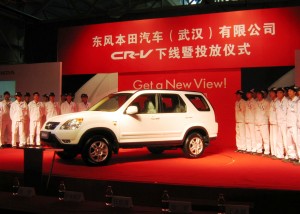
Chinese automakers are rapidly increasing exports. Honda will soon use its Chinese factory to produce the small Fit for Canada.
While the final sales and production numbers from 2011 are still being tallied one new numbers is bound to catch attention of executives and analysts from Tokyo, to Stuttgart and Detroit.
Chinese automakers exported more than 1 million finished vehicles to markets all around the world, according to new data coming out of the Asian nation. Chinese carmakers, however, have bypassed the big “Triad” markets in North America, Europe and Japan and have instead focused on exporting vehicles to emerging markets in Africa, South America, the Middle East and South Asia.
That could change, however, as Honda has announced plans to export some of its Chinese-made Fit subcompacts to Canada, while Geely has set up a U.S. headquarters in Los Angeles that could be followed by a small number of imports this year. Nonetheless, it appears the Chinese are betting their best opportunity will come from emerging markets.
In South America, the Chinese automakers already have emerged as a “disruptive force,” challenging the domination of long-established American and European brands such as Chevrolet, Fiat and Volkswagen.
Brazil is considered one of the global industry’s fastest growing and most desirable markets for new vehicles because of its rapidly expanding middle class. Makers ranging from Fiat to General Motors to Nissan have been growing their production base to keep up with demand, but suddenly, they’re facing a serious threat to the market’s established order, noted several Brazilian executives and journalists visiting Detroit for this year’s North American International Auto Show.
Chinese carmakers such as Chery are offering very attractive prices on the vehicles. While Chinese-made vehicles may be less expensive than established brands, Brazilian consumers aren’t completely convinced the Asian offerings are truly competitive. “The prices are very good, but people don’t have a lot of confidence,” said one of the Brazilian visitors.
Nonetheless, exporting a million vehicles is quite an achievement for the Chinese auto industry, which barely existed just 20 years ago. Only a handful of countries, such as Japan, Germany, South Korea and Mexico, can claim to have exported more or as many vehicles as the Chinese. And few industry analysts believe the Chinese export wave will level off anytime soon.
If anything, with their domestic market beginning to cool off after years of double-digit growth, Chinese makers like Chery and Geely could be pressed to increase exports to maintain their momentum.
So far, the Chinese companies appear satisfied the strategy is working. After years of bringing products to Detroit to highlight their eventual plans to export to the U.S., Chinese makers like Geely didn’t even bother to set up any exhibits at this year’s North American International Auto Show.
